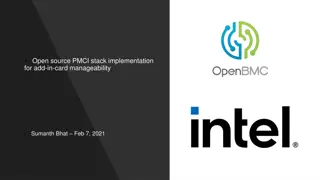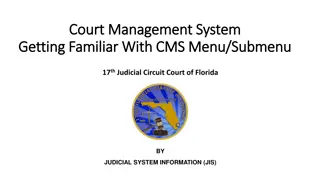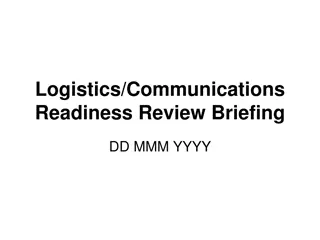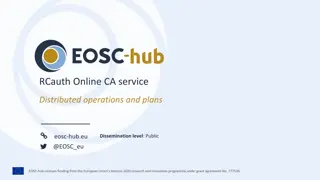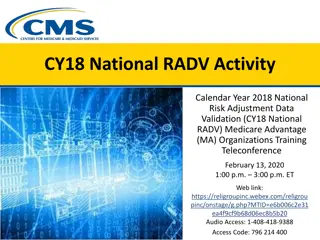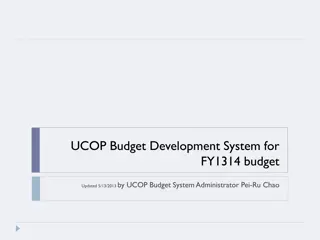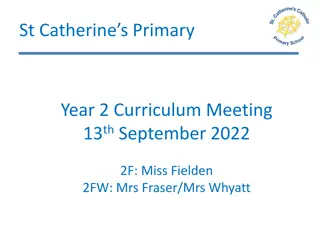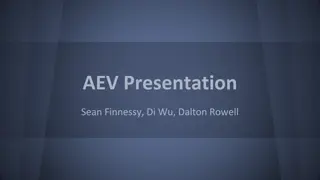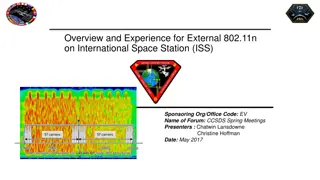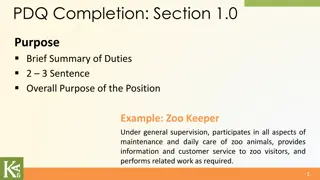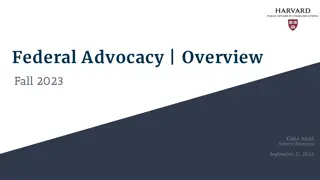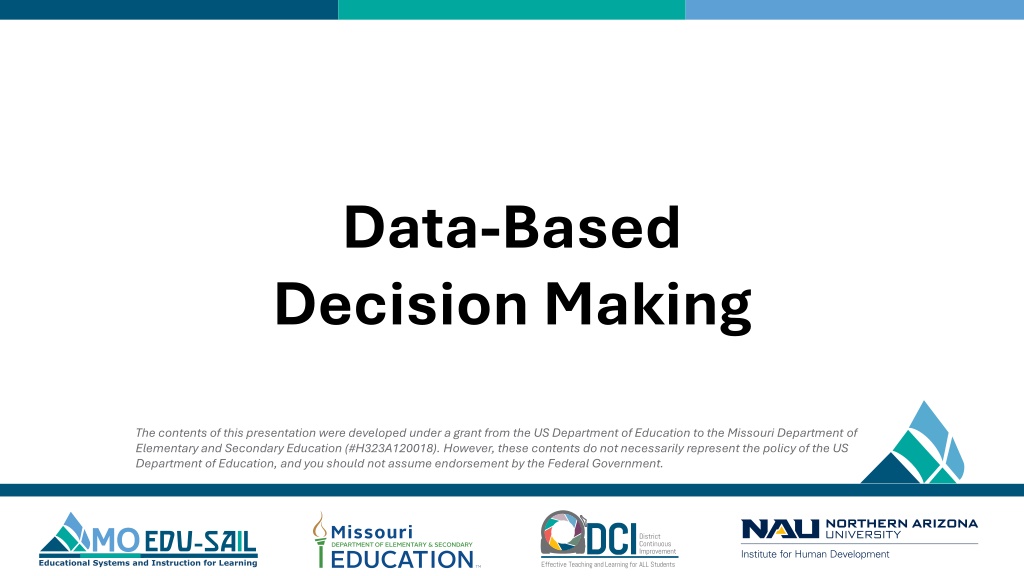
Data-Based Decision Making in Education Module
Learn about data-based decision making in education through a professional learning module developed under a grant from the US Department of Education. Explore topics such as effective instruction, collaborative teams, formative assessment, and aligning with learning standards. Enhance your teaching practices and student outcomes with valuable insights and strategies.
Download Presentation

Please find below an Image/Link to download the presentation.
The content on the website is provided AS IS for your information and personal use only. It may not be sold, licensed, or shared on other websites without obtaining consent from the author. Download presentation by click this link. If you encounter any issues during the download, it is possible that the publisher has removed the file from their server.
E N D
Presentation Transcript
Data-Based Decision Making The contents of this presentation were developed under a grant from the US Department of Education to the Missouri Department of Elementary and Secondary Education (#H323A120018). However, these contents do not necessarily represent the policy of the US Department of Education, and you should not assume endorsement by the Federal Government.
Acknowledgements Special thanks to all contributors to the development and revision of this professional learning module. The original collection of professional learning modules was rolled-out for use by Regional Professional Development Center (RPDC) Consultants in July 2013 after being developed by a team of content experts through efforts funded by the Missouri State Personnel Development Grant (SPDG). MoEdu-SAIL Ronda Jenson Sarah Marten Beverly Kohzadi Cynthia Beckmann Jodi Arnold Arden Day RPDCs DeAun Blumberg, St. Louis Heidi Newlon, Kansas City Julie Germann, Southwest Linda Null, Southeast ClauDean Kizart, St. Louis Tammy Ratliff, Northeast Debi Korell, Northwest SPDG Management Team
Welcome and Introductions Our trainers for the day
Norms Begin and end on time Be an engaged participant Be an active listener open to new ideas Use notes for side bar conversations Use electronics respectfully
DCI Framework Focus on effective instruction leading to exceptional outcomes for ALL Missouri students Foundations Collaborative Teams Data-Based Decision Making Common Formative Assessment Effective Teaching and Learning Practices Developing Assessment Capable Learners > Feedback Metacognition Supportive Context School-Based Implementation Coaching Collective Teacher Efficacy Systems Leadership Instructional Leadership
DBDM Alignment with MO Learning Standards Ensures students learn essential and higher order knowledge and skills as identified by the MO Learning Standards through: Teacher Collaboration Reflection Data Analysis Action Planning Feedback
DBDM Alignment with MO Teacher Standards This DBDM module supports the following MO Teacher Standards: #2 Student Learning, Growth, and Development: Teachers can adapt instruction in order to effectively teach all learners #7 Student Assessment and Data Analysis: Teachers uses formative and summative assessment strategies to assess learner progress #8 Professionalism: Teachers are reflective practitioners and use data to inform reflection #9 Collaboration: Teachers collaborate with a shared goal of effective instruction and student learning
Session-at-a-Glance The Why: Purpose and benefits of DBDM Alignment of DBDM with MO standards for teaching and learning Addressing common roadblocks to DBDM The DBDM Process: GAINS 1. Gather 2. Analyze 3. Intentionally act and analyze again 4. Notice and adjust 5. Systematically repeat the GAINS process Next Steps: Assessment, Reflection, and Action Planning
Essential Questions 1. Why must a process for effective DBDM be used and what should that process include? How should a DBDM plan be designed and implemented to best meet the needs of your team and to significantly improve student outcomes? How will roadblocks to DBDM be overcome? 2. 3.
Learning Targets Educators will: Identify the steps and qualities of a DBDM process for effectively analyzing student data to adjust instruction and improve student outcomes. Anticipate and overcome roadblocks that limit the DBDM process. Design an action plan to implement the DBDM process that is tailored to the needs of the DBDM team.
This Approach to Data-Based Decision Making Reflects a synthesis of common processes and concepts found across the vast body of DBDM literature Emphasizes using data to improve instruction for all students, not only those who are struggling Promotes commitment to deep reflection, process, and follow-through Relies on evidence of learning (data) to guide collaboration Accounts for common roadblocks and includes steps for overcoming them
What are the benefits of DBDM? Teachers: Insight into what really works o How instruction truly impacts student learning o Decisions based on facts not hunches Awareness of student strengths and misconceptions Supports ways of engaging students in assessing their own learning Data to inform and improve building-wide instructional goals Improved level of collective efficacy Students: Improved learning from improved teaching Deeper understanding of content Higher rates of success
DBDM Roadblocks Roadblocks to DBDM in my experience: 1. We never got past the data gathering stage 2. We didn t have time to follow up 3. We didn t know what to do next 4. We didn t have a plan for how to address the problem we found 5. Following up with myself is harder than being accountable to my colleagues 6. We had no idea how to solve the problem(s) we found
Data-Based Decision Making Cycle: GAINS du ators ollaborate to de ide what data to olle t du ators develop a pro ess for examinin and interpre n data du ators repeat the steps with new data to promote meanin ful ains in student learnin Streamlined cycle Deliberate process connecting actions to outcomes du ators develop a pro ess for providin and usin feedba k du ators determine instru onal a on steps
GAINS Jingle GAINS is a system to help students achieve Gather purposeful data and teams that believe Analyze thorou hly, then Intentionally act desi n instru tional plans to put kids ba k on track! Notice thy impa t adjust and refine Systematically repeat GAINS one more time!
A Comparison A side-by-side look at Essential Functions (EF) and GAINS EF 1: Educators establish a collaborative process for collecting data. GAINS Step 1: Gather EF 2: Educators implement a process for examining and interpreting data. GAINS Step 2: Analyze EF 3: Educators determine instructional action steps. GAINS Step 3: Intentionally act and analyze again EF 4: Educators use and act upon data by incorporating teaching and learning data into instruction and adjusting instruction accordingly. GAINS Step 4: Notice and adjust. The following section will take a closer look at each essential function, how it fits together with GAINS, and show action steps that will help you in this process!
EF 1 and GAINS Steps In Action EF 1 and GAINS Step 1 Actions Roadblocks Educators establish a collaborative process for collecting data = GATHER Gather as a team using a collaborative structure Lack of a scheduled ongoing time for the team to meet. No team roles - thin s don t et done Too much or not enough data. Gather informational data Not enough time or *motivation to dig into the data. Become familiar with the data
What does collaboration look like? Form a data team Define roles: shifting and sharing roles is important Set re ular time to meet: don t skip Create agenda: share responsibility or identify one person to create EF 1 and GAINS Step 1 Actions Educators establish collaborative process for collecting data = GATHER Gather as a team using a collaborative structure Gather informational data Become familiar with the data
EF 1 Video Reflection: How is this team collaborating? Review this Team Collaboration Video What kind of team? What do they do right? How could the meeting be improved? EF 1 and GAINS Step 1 Actions Educators establish collaborative process for collecting data = GATHER Gather as a team using a collaborative structure Gather informational data Become familiar with the data
What data should you use? What answers are we trying to find? EF 1 and GAINS Step 1 Actions o What data will give us that information? Gather a range of data that provides info about: Educators establish collaborative process for collecting data = GATHER Gather as a team using a collaborative structure o What students know and don t know o What s workin and what s not, instru tionally Gather informational data Become familiar with the data
What is in the range of data? Formative EF 1 and GAINS Step 1 Actions o Student self-assessments o Descriptive feedback Educators establish collaborative process for collecting data = GATHER Gather as a team using a collaborative structure o Daily writing samples o Common formative assessments Summative Gather informational data o End-of-unit tests o Common grade-level tests Standardized Become familiar with the data o State assessments (MAP) *Be realistic about the amount of data you are able to analyze. o District interim or end of year assessment
How do we become familiar? Spend some time studying the data Increase comfort with it as a group or individually Focus on problems with highest potential to advance student learning As a group, hold ourselves accountable EF 1 and GAINS Step 1 Actions Educators establish collaborative process for collecting data = GATHER Gather as a team using a collaborative structure Gather informational data Become familiar with the data
EF 1 Activity DBDM Mock Data Team Open your DBDM Workbook to Essential Function 1 Activity Form groups of 4-5 people o Should be similar to what a data team might look like in your building (similar content, grade level, if possible) Work through the Essential Function 1 steps in the workbook as though you are in a real team
EF 2 and GAINS Step 2 In Action EF 2 and Actions Roadblocks GAINS Step 2 Educators implement a process for examining and interpreting data = Analyze Develop a purposeful data analysis system Meetings are off-topic. Haphazard system for analysis, lack of protocol. Identify a common problem and relate it to a learning goal or target Problem does not address learning target. Analysis viewed personally rather than objectively. Predict a link to teacher practice Focus on a student weakness rather than a teacher practice. The data to examine not clearly defined.
How will your team analyze data? EF 2 and GAINS Step 2 As a team, decide on a purposeful data analysis system for examining data: 1. Establish data meeting guidelines 2. Develop and use a systematic data meeting protocol Actions Educators implement a process for examining and interpreting data = Analyze Develop a purposeful data analysis system Identify a common problem and relate it to a learning goal or target o When will you meet? o How often? o How will you document meetings? 3. Share items to add to the data meeting agenda for each meeting Predict a link to teacher practice
What are data meeting guidelines? Overarching thoughts about how the data team will function Overarching data analysis goals Keep the meetings focused and safe Will not change meeting to meeting EF 2 and GAINS Step 2 Actions Educators implement a process for examining and interpreting data = Analyze Develop a purposeful data analysis system Identify a common problem and relate it to a learning goal or target Predict a link to teacher practice
Sample Data Meeting Guidelines Be honest about what the data is saying about your current reality. No blaming. Focus on what the data says about the progress of each student. Recognize that it is not about YOU. It is about what you can do next to improve ea h student s level of su ess The data is not a refle tion of your tea hin It is a reflection of student learning. Reflect on how unit activities or student strategies can be revised. Share best practices as well as things that may not have worked as planned. Review the assessment to assure it effectively measures the student learning objectives.
What is a DBDM Meeting Protocol? Systematic step-by-step process used for analyzing data Resist the urge to skip the protocol during meetings Will not change meeting to meeting EF 2 and GAINS Step 2 Actions Educators implement a process for examining and interpreting data = Analyze Develop a purposeful data analysis system Identify a common problem and relate it to a learning goal or target Predict a link to teacher practice
Sample Data Meeting Protocol Summary Before the meeting: each team member has a copy of the latest classroom data, has reviewed it, and brings a copy to the meeting Introduction (2 min): Begin the meeting Sharing (5 min): Successes and ideas Current Challenges (5 min): Focus areas Proposed Solutions (10 min): Brainstorm strategies as a team Action Plan (10 min): Agree on a strategy Closing the meeting (5 min): Debrief and summarize After the meeting: Distribute notes and summaries
What is a Data Meeting Agenda? Goals we want accomplish during this specific meeting Talking points Questions Accessible by each team member (shared folder) Will change meeting to meeting EF 2 and GAINS Step 2 Actions Educators implement a process for examining and interpreting data = Analyze Develop a purposeful data analysis system Identify a common problem and relate it to a learning goal or target o Resist the urge to wander off topic Predict a link to teacher practice
Dig into the data Many different approaches Unique to personality of team and type of data chosen Review this Analyzing Student Work Video to view an example of how one team analyzes student work EF 2 and GAINS Step 2 Actions Educators implement a process for examining and interpreting data = Analyze Develop a purposeful data analysis system Identify a common problem and relate it to a learning goal or target Predict a link to teacher practice
Identify a common problem Teams systematically examine the data EF 2 and GAINS Step 2 Actions o Develop a common method for examining the data Educators implement a process for examining and interpreting data = Analyze Develop a purposeful data analysis system o Review Sample Data Analysis Form Decide on the problem the team wants to address The problem identified should be related to a learning goal Identify a common problem and relate it to a learning goal or target Predict a link to teacher practice
What are WE doing related to the common problem? After deciding on a problem to address: Review Sample Link to Teacher Practice Form Reflect on possible connections Reflect what might (or might not) be happening during instruction related to the problem Think about how instruction can change to advance student learning EF 2 and GAINS Step 2 Actions Educators implement a process for examining and interpreting data = Analyze Develop a purposeful data analysis system Identify a common problem and relate it to a learning goal or target Predict a link to teacher practice
EF 2 Video Reflection: Predict a link to teacher practice Starting at 1:08, review this PLCs at Work Video to view an example of how one team analyzes student work What was the team s approa h for identifying common student problems? How did the team examine the link between teacher practice and outcomes? EF 2 and GAINS Step 2 Actions Educators implement a process for examining and interpreting data = Analyze Develop a purposeful data analysis system Identify a common problem and relate it to a learning goal or target Predict a link to teacher practice
EF 2 Activity DBDM Mock Data Team Open your DBDM Workbook to Essential Function 2 Activity Gather again as a group Work through the EF 2 steps in the workbook as though you are in a real team
EF 3 and GAINS Step 3 In Action EF 3 and GAINS Step 3 Actions Roadblocks Educators determine instructional action steps = Intentionally Act & Analyze Again Create an instructional action plan that addresses the predicted breakdown Data collects dust throughout the year. No plan exists to act on the data. Connections between instruction and learning overlooked. Implement the plan, make instructional change, and generate MORE evidence data Vague learning goal.
Have we helped students yet? During Step Two, identified a link to teacher practice. Time to ACT Being intentional is key MOST DIFFICULT STEP in the process! EF 3 and GAINS Step 3 Actions Educators determine instructional action steps = Intentionally Act & Analyze Again Create an instructional action plan that addresses the predicted breakdown Implement the plan, make instructional change, and generate MORE evidence data
What action are we going to take? The Instructional Action Plan (IAP) should include: EF 3 and GAINS Step 3 Actions Educators determine instructional action steps = Intentionally Act & Analyze Again Create an instructional action plan that addresses the predicted breakdown o Learning Goal o Evidence of Learning o Instructional Change o Method for examining instruction o Impact analysis Implement the plan, make instructional change, and generate MORE evidence data
IAP: 1. Learning Goal Based on the common problem established during Step Two. Should address the questions: EF 3 and GAINS Step 3 Actions Educators determine instructional action steps = Intentionally Act & Analyze Again Create an instructional action plan that addresses the predicted breakdown o What is the problem we want to address? o What do we really want our students to know and do? Implement the plan, make instructional change, and generate MORE evidence data
IAP: 2. Evidence of learning Based on the common problem Should be informed by student work re: what s workin and what s not Should indicate how students are progressing toward the learning goal Should advance students toward the learning goal EF 3 and GAINS Step 3 Actions Educators determine instructional action steps = Intentionally Act & Analyze Again Create an instructional action plan that addresses the predicted breakdown Implement the plan, make instructional change, and generate MORE evidence data
IAP: 3. Instructional Change How will we solve the problem? Design a lesson or set of lessons that addresses the problem identified in Step Two EF 3 and GAINS Step 3 Actions Educators determine instructional action steps = Intentionally Act & Analyze Again Create an instructional action plan that addresses the predicted breakdown Implement the plan, make instructional change, and generate MORE evidence data
IAP: 4. Method for Examining Instruction How will we hold ourselves accountable? Choose any method for examining instruction EF 3 and GAINS Step 3 Actions Educators determine instructional action steps = Intentionally Act & Analyze Again Create an instructional action plan that addresses the predicted breakdown o Lesson Study o Instructional Rounds o Video o Teacher Labs (observe, reflect discuss) Implement the plan, make instructional change, and generate MORE evidence data o Reflection log o Other option
IAP: 5. Impact analysis Review and use the previously developed data analysis system How will we assess the impact of the instructional change? EF 3 and GAINS Step 3 Actions Educators determine instructional action steps = Intentionally Act & Analyze Again Create an instructional action plan that addresses the predicted breakdown Implement the plan, make instructional change, and generate MORE evidence data
Moving students forward Be systematic and intentional: Follow your plan Pair up with someone to be your coach: Work with a partner to implement your plan and help you stay on track EF 3 and GAINS Step 3 Actions Educators determine instructional action steps = Intentionally Act & Analyze Again Create an instructional action plan that addresses the predicted breakdown Implement the plan, make instructional change, and generate MORE evidence data
EF 3 Activity Methods for Examining Instruction Open your DBDM Workbook to the Essential Function 3 Activity Gather as a group to watch a video highlighting a method for examining instruction o What is Lesson Study o Instructional Rounds Watch the video, discuss and answer the guiding questions. Do the Stay and Stray Activity, so all become familiar with the four methods. o Each group should have at least one computer with video and sound capabilities for watching a video
EF 4 and GAINS Step 4 In Action EF 4 and GAINS Step 4 Actions Roadblocks Educators use and act upon data by incorporating teaching and learning data into instruction and adjusting instruction accordingly = Notice & Adjust During the instructional plan implementation Review and use purposeful data analysis system Reflect on the impact of the instructional change (what worked, what did not work, and why) Involve students Adjust instructional action plan No system in place to assess instructional impact. Implementation happens, but refle tion doesn t Do all the work, but never know thy impact. Student feedback is difficult to incorporate. This work is hard and takes time.

![❤[READ]❤ Deep Space Craft: An Overview of Interplanetary Flight (Springer Praxis](/thumb/21511/read-deep-space-craft-an-overview-of-interplanetary-flight-springer-praxis.jpg)




